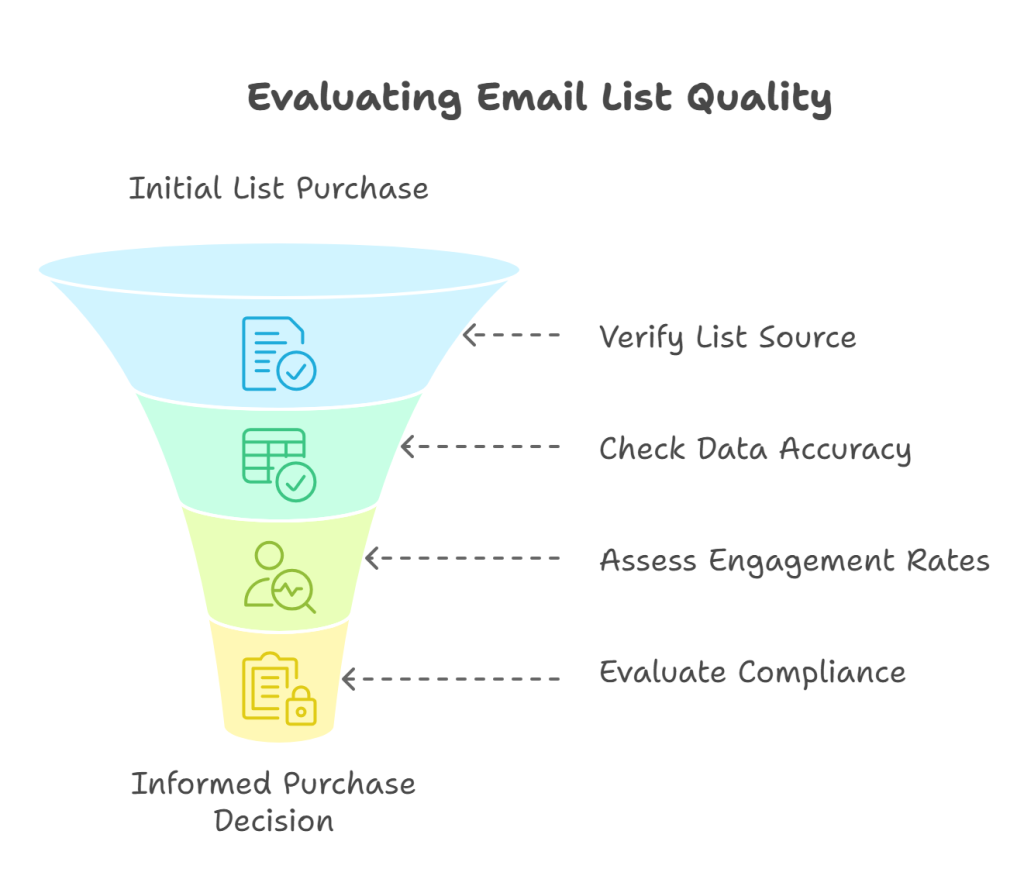Are you a marketer in the fast-paced tech industry, constantly seeking an edge in lead generation? Perhaps you’ve hit a wall, your pipeline isn’t as robust as you’d like, and you’re feeling the pressure to deliver results.
In moments like these, the idea of a “ready-made” technology email list – a seemingly endless database of potential clients just waiting for your message – can appear incredibly alluring. It promises a quick fix, a bypass to the often-lengthy process of building an audience from scratch.
But here’s the critical truth: while seemingly a shortcut, purchasing technology email lists often leads to more problems than solutions, including poor ROI, legal risks, and irreversible damage to your brand reputation. This article will equip marketers with the knowledge to understand these pitfalls and explore more effective, ethical alternatives.
The Allure and the Reality: Why Purchased Lists Seem Appealing (and Why They Aren’t)
The initial appeal of purchasing email lists for your B2B tech marketing efforts is undeniable. Imagine instant access to thousands, even tens of thousands, of contacts overnight.
It promises to dramatically reduce the time and resources typically invested in lead generation strategies, making it seem like a cost-effective alternative to organic list building. The idea of bypassing the often-arduous journey of attracting and nurturing leads can be a powerful motivator for any marketer under pressure.
However, this perceived efficiency is often a costly illusion, quickly giving way to a harsh reality. The most significant issue is the low quality data inherent in most purchased lists.

These lists are frequently outdated, filled with inaccurate job titles, defunct email addresses, or individuals who have long since moved on from their listed positions within the tech sector.
This lack of segmentation means you’re often targeting a broad, undifferentiated group when your ideal customer profile requires precision.
This poor data quality directly translates into poor engagement metrics. When you send emails to recipients who haven’t opted in or have no interest in your offerings, you’ll experience significantly lower open rates and abysmal click-through rates.
Concurrently, your bounce rates will skyrocket as messages hit non-existent inboxes. To put this into perspective, general industry benchmarks show that purchased lists often yield open rates below 5%, compared to opt-in lists which can achieve 20-30% or higher.
The same disparity holds true for click-through rates. These dismal figures aren’t just disheartening; they signal a critical problem: your messages aren’t reaching, let alone resonating with, your target audience.
The gravest consequence, however, is the risk of spam complaints and block listing. When your emails land in the inboxes of unconsenting recipients, they are far more likely to mark your messages as spam. A high volume of spam complaints alerts Internet Service Providers (ISPs) and Email Service Providers (ESPs) that your sending practices are problematic.
This can lead to your IP address and domain being flagged or even outright block listed, severely damaging your email deliverability. Once your sender reputation is tarnished, all your email campaigns, including legitimate communications with existing customers, will suffer, often landing directly in spam folders regardless of their content or the recipient’s prior consent.
The Legal and Ethical Minefield
Beyond the practical pitfalls, purchasing technology email lists ushers you into a complex legal and ethical minefield, particularly concerning data privacy. Ignoring these regulations isn’t just risky; it can lead to severe penalties and irreparable harm to your brand.
A. Navigating Data Privacy Regulations:
The landscape of data privacy is becoming increasingly stringent. Two key regulations stand out for marketers:
- GDPR (General Data Protection Regulation): If your target audience includes anyone within the European Union, or if your company is based there, GDPR compliance is non-negotiable. GDPR mandates explicit consent for processing personal data, meaning individuals must actively agree to receive communications from you. Purchased lists almost never have this verifiable consent. Consequences of non-compliance can be catastrophic, with fines reaching up to €20 million or 4% of global annual turnover, whichever is higher, in addition to significant reputational damage.
- CAN-SPAM Act (Controlling the Assault of Non-Solicited Pornography And Marketing Act): Applicable in the United States, the CAN-SPAM Act sets rules for commercial emails. While it doesn’t require explicit opt-in, it does mandate clear identification of the sender, truthful subject lines, a physical postal address, and, crucially, a clear and conspicuous mechanism for recipients to opt out of future emails. Violations can result in hefty fines per email sent.
It’s also important to be aware of other regional regulations, such as the CCPA (California Consumer Privacy Act) in the US, which further emphasize consumer data rights. The complexity and strict enforcement of these laws make relying on potentially non-compliant purchased lists a tremendous gamble.
B. Ethical Implications and Brand Damage:
Beyond legal repercussions, the ethical implications of using purchased lists are profound. Sending intrusive and unwelcomed emails to individuals who haven’t opted in is fundamentally disrespectful of their privacy.
This unsolicited cold email outreach strategy often leads recipients to perceive your brand as “spammy” or unprofessional. This erosion of trust can be incredibly damaging to your professional image and make future marketing efforts far more challenging.
Imagine a recipient’s negative reaction: “How did they get my email? I never signed up for this!” This immediate negative association can stick, making it difficult to ever win that person’s business or even their attention.
Smarter Alternatives: Building High-Quality Technology Email Lists Organically
The good news is that there are far more effective and ethical ways to build a high-quality email list for your B2B tech marketing efforts. These methods focus on attracting genuinely interested prospects and fostering long-term relationships.
A. Content Marketing and Inbound Strategies:
This is the cornerstone of modern lead generation strategies.
- Valuable Content: Create and distribute insightful blog posts, in-depth whitepapers, compelling case studies, expert-led webinars, and informative eBooks. This content should directly address the pain points and interests of your target tech audience.
- Lead Magnets: Offer this exclusive content as “lead magnets,” requiring an email address for download. This ensures that only those genuinely interested in your solutions will provide their contact information.
- SEO: Optimize your content for search engines (SEO) to ensure it’s discoverable by tech professionals actively searching for solutions you provide.
B. Strategic Partnerships and Collaboration:
Collaborate with complementary businesses in the tech ecosystem.
- Co-hosted Webinars: Partner with a non-competing tech company for a joint webinar, leveraging each other’s audience.
- Joint Whitepapers: Co-create valuable research or thought leadership pieces.
- Cross-Promotional Efforts: Leverage each other’s email lists (with mutual consent from both parties’ subscribers) for specific, relevant promotions.
C. Professional Networking and Events:
- Industry Conferences & Trade Shows: Attend and participate in relevant tech industry events. These provide invaluable opportunities for direct engagement and collecting opt-ins from genuinely interested individuals.
- LinkedIn and Other Professional Platforms: Engage in meaningful conversations, share expertise, and connect with potential leads. While direct email solicitation is discouraged, building relationships can naturally lead to interest in your content and, subsequently, opt-ins.
D. Website Optimization and Clear Opt-in Forms:
- Prominently Placed and User-Friendly Subscription Forms: Ensure your website has clear, easy-to-find forms for newsletter subscriptions or content downloads.
- Clear Value Proposition: Articulate what subscribers will gain by providing their email address – exclusive content, industry insights, early access to product updates.
E. Leveraging Existing Customer Data (Ethically):
- Segmenting Current Customers: Use your existing customer database to identify opportunities for upselling or cross-selling, but always within the bounds of their initial consent.
- Referral Programs: Encourage satisfied clients to refer colleagues, often incentivizing both the referrer and the new lead. This generates highly qualified, permission-based leads.
Due Diligence: If You Absolutely Must Consider a Purchased List (A Last Resort)
Despite the overwhelming evidence against them, some marketers might still feel compelled to consider a purchased list as a “last resort.” If you find yourself in this situation, extreme caution and rigorous due diligence are paramount.
A. Unveiling the Vendor’s Practices:
- Source of Data: The most critical question: How was the data collected? A reputable vendor might be able to provide some insight, but verifiable, explicit consent for each contact is almost impossible for a mass-purchased list.
- Update Frequency: How often is the list cleaned and updated? High-quality lists are constantly pruned for outdated or inactive addresses.
- Opt-in Status: Can the vendor prove consent for each contact on the list? If they can’t provide verifiable evidence, assume there is none.
- Data Segmentation and Specificity: Can they provide highly targeted lists that align precisely with your ideal customer profile, going beyond generic “tech professionals” to specific roles, company sizes, or technology stacks?
B. Trial and Error (with extreme caution):
- Small, Highly Segmented Lists: If you proceed, start incredibly small. Request a tiny, highly segmented sample of a few hundred contacts, not thousands.
- Separate Sending IP Address: Crucially, use a completely separate sending IP address or even a new, temporary domain for these test campaigns. This protects your primary sender reputation from potential damage if the list performs poorly.
- Closely Monitor Metrics: Obsessively track engagement, bounce rates, and spam complaints from the very first email. Be prepared to abandon the list immediately if performance is dismal.
C. The True Cost Analysis:
Factor in all potential costs, not just the upfront purchase price. Consider the long-term impact of low deliverability, increased spam traps, direct spam complaints, lost sales opportunities due to negative brand perception, and the potential for legal fines.
When these hidden costs are accounted for, the email marketing ROI from purchased lists almost always proves to be negative.
Final Thoughts
The appeal of a quick fix in lead generation strategies can be powerful, and the notion of readily available technology email lists often seems like an irresistible shortcut.
However, the comprehensive truth is that such lists typically deliver low-quality data, abysmal engagement, significant legal risks under acts like GDPR and CAN-SPAM, and ultimately, irreversible damage to your sender reputation and brand image. True, sustainable success in B2B tech marketing hinges not on the quantity of contacts, but on the quality of relationships.
Therefore, invest your marketing budget in strategies that build high-quality, engaged email lists organically. Prioritize valuable content, authentic engagement, and ethical data acquisition to foster lasting customer relationships and drive sustainable growth in the technology sector.
The time and effort spent building an opt-in list will yield far greater email marketing ROI and ensure your outreach is both effective and compliant.


